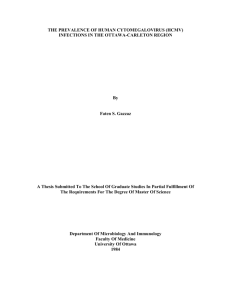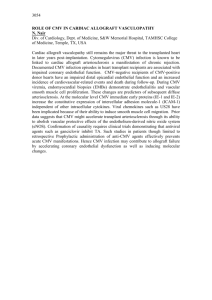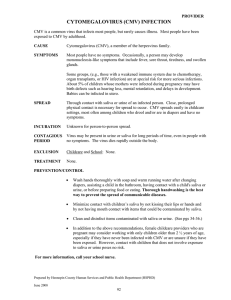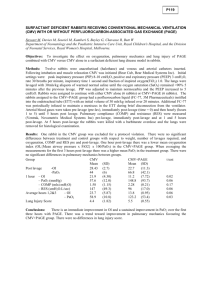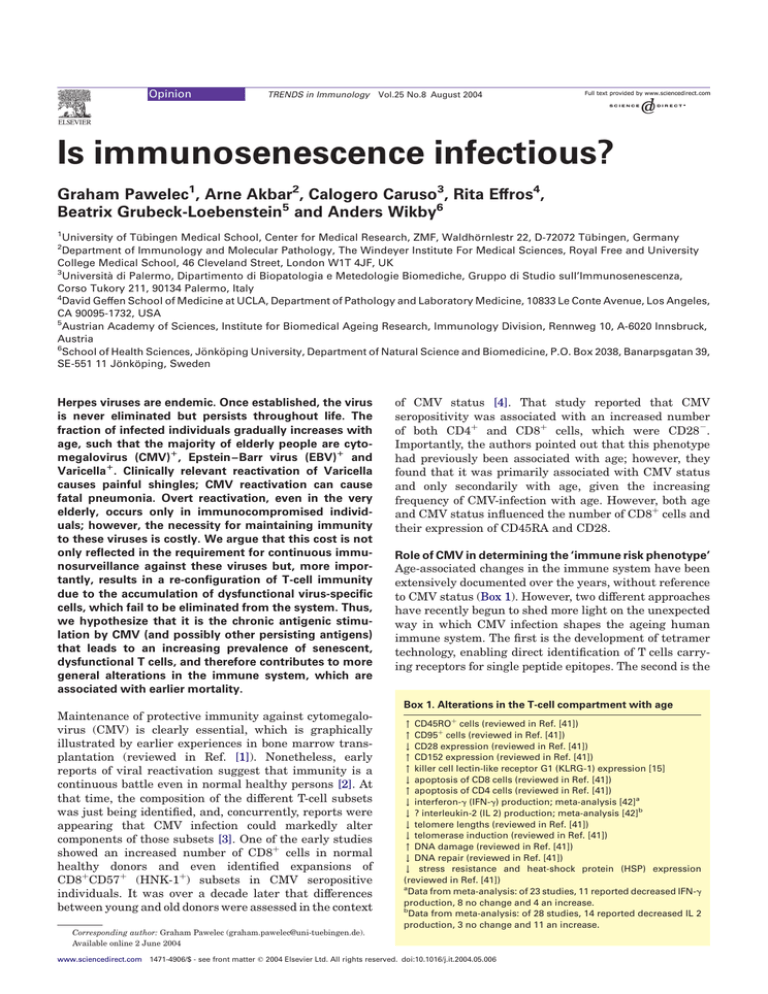
Opinion
TRENDS in Immunology
Vol.25 No.8 August 2004
Is immunosenescence infectious?
Graham Pawelec1, Arne Akbar2, Calogero Caruso3, Rita Effros4,
Beatrix Grubeck-Loebenstein5 and Anders Wikby6
1
University of Tübingen Medical School, Center for Medical Research, ZMF, Waldhörnlestr 22, D-72072 Tübingen, Germany
Department of Immunology and Molecular Pathology, The Windeyer Institute For Medical Sciences, Royal Free and University
College Medical School, 46 Cleveland Street, London W1T 4JF, UK
3
Università di Palermo, Dipartimento di Biopatologia e Metedologie Biomediche, Gruppo di Studio sull’Immunosenescenza,
Corso Tukory 211, 90134 Palermo, Italy
4
David Geffen School of Medicine at UCLA, Department of Pathology and Laboratory Medicine, 10833 Le Conte Avenue, Los Angeles,
CA 90095-1732, USA
5
Austrian Academy of Sciences, Institute for Biomedical Ageing Research, Immunology Division, Rennweg 10, A-6020 Innsbruck,
Austria
6
School of Health Sciences, Jönköping University, Department of Natural Science and Biomedicine, P.O. Box 2038, Banarpsgatan 39,
SE-551 11 Jönköping, Sweden
2
Herpes viruses are endemic. Once established, the virus
is never eliminated but persists throughout life. The
fraction of infected individuals gradually increases with
age, such that the majority of elderly people are cytomegalovirus (CMV)1, Epstein– Barr virus (EBV)1 and
Varicella1. Clinically relevant reactivation of Varicella
causes painful shingles; CMV reactivation can cause
fatal pneumonia. Overt reactivation, even in the very
elderly, occurs only in immunocompromised individuals; however, the necessity for maintaining immunity
to these viruses is costly. We argue that this cost is not
only reflected in the requirement for continuous immunosurveillance against these viruses but, more importantly, results in a re-configuration of T-cell immunity
due to the accumulation of dysfunctional virus-specific
cells, which fail to be eliminated from the system. Thus,
we hypothesize that it is the chronic antigenic stimulation by CMV (and possibly other persisting antigens)
that leads to an increasing prevalence of senescent,
dysfunctional T cells, and therefore contributes to more
general alterations in the immune system, which are
associated with earlier mortality.
of CMV status [4]. That study reported that CMV
seropositivity was associated with an increased number
of both CD4þ and CD8þ cells, which were CD282.
Importantly, the authors pointed out that this phenotype
had previously been associated with age; however, they
found that it was primarily associated with CMV status
and only secondarily with age, given the increasing
frequency of CMV-infection with age. However, both age
and CMV status influenced the number of CD8þ cells and
their expression of CD45RA and CD28.
Role of CMV in determining the ‘immune risk phenotype’
Age-associated changes in the immune system have been
extensively documented over the years, without reference
to CMV status (Box 1). However, two different approaches
have recently begun to shed more light on the unexpected
way in which CMV infection shapes the ageing human
immune system. The first is the development of tetramer
technology, enabling direct identification of T cells carrying receptors for single peptide epitopes. The second is the
Box 1. Alterations in the T-cell compartment with age
Maintenance of protective immunity against cytomegalovirus (CMV) is clearly essential, which is graphically
illustrated by earlier experiences in bone marrow transplantation (reviewed in Ref. [1]). Nonetheless, early
reports of viral reactivation suggest that immunity is a
continuous battle even in normal healthy persons [2]. At
that time, the composition of the different T-cell subsets
was just being identified, and, concurrently, reports were
appearing that CMV infection could markedly alter
components of those subsets [3]. One of the early studies
showed an increased number of CD8þ cells in normal
healthy donors and even identified expansions of
CD8þCD57þ (HNK-1þ) subsets in CMV seropositive
individuals. It was over a decade later that differences
between young and old donors were assessed in the context
" CD45ROþ cells (reviewed in Ref. [41])
" CD95þ cells (reviewed in Ref. [41])
# CD28 expression (reviewed in Ref. [41])
" CD152 expression (reviewed in Ref. [41])
" killer cell lectin-like receptor G1 (KLRG-1) expression [15]
# apoptosis of CD8 cells (reviewed in Ref. [41])
" apoptosis of CD4 cells (reviewed in Ref. [41])
# interferon-g (IFN-g) production; meta-analysis [42]a
# ? interleukin-2 (IL 2) production; meta-analysis [42]b
# telomere lengths (reviewed in Ref. [41])
# telomerase induction (reviewed in Ref. [41])
" DNA damage (reviewed in Ref. [41])
# DNA repair (reviewed in Ref. [41])
# stress resistance and heat-shock protein (HSP) expression
(reviewed in Ref. [41])
a
Data from meta-analysis: of 23 studies, 11 reported decreased IFN-g
production, 8 no change and 4 an increase.
b
Data from meta-analysis: of 28 studies, 14 reported decreased IL 2
production, 3 no change and 11 an increase.
Corresponding author: Graham Pawelec (graham.pawelec@uni-tuebingen.de).
Available online 2 June 2004
www.sciencedirect.com 1471-4906/$ - see front matter q 2004 Elsevier Ltd. All rights reserved. doi:10.1016/j.it.2004.05.006
Opinion
TRENDS in Immunology
deployment of longitudinal studies of the naturally ageing
population to begin to identify factors predicting mortality.
In the Swedish longitudinal study, known as the OCTO
study [5], age-related changes in several immune parameters are being investigated by monitoring a free-living
population over time. Values for a cluster of parameters,
including high CD8, low CD4 and poor proliferative
response to concanavalin A (Con A), were found to predict
higher two-year mortality in a relatively homogeneous
population from this one city, selected only by virtue of
having survived to the age of 80 [6]. This cluster was
designated the ‘immune risk phenotype’ (IRP) [7] (Box 2).
These results were confirmed in a second two-year followup, which also showed that additional individuals had
moved into the IRP category during those two years [8].
Later, it became apparent that CMV seropositivity was
significantly associated with the IRP [9]. The immune
changes were confirmed in the subsequent Swedish NONA
longitudinal study [10], which pinpointed the CD8þCD272CD282CD57þCD45RAþ phenotype as markedly
expanded for individuals in the risk category. Importantly,
this study also indicated that the risk phenotype was
independent of the health status of the individual at that
particular time [11]. Therefore, at least in the already
elderly population, a cluster of immune parameters,
including CMV status, can be identified, which accurately
predicts mortality. What causes an individual to reside in
the IRP category or to move into it as they age? Our
hypothesis is that this state is strongly influenced by the
ability of the individual to manage the consequences of
CMV infection.
The OCTO and NONA samples have now also been
examined using MHC – peptide tetramers capable of
identifying CD8þ T cells from HLA-A*0201þ donors;
these CD8þ T cells carry T-cell receptors for the immunodominant human CMV pp65-derived epitope Nlvpmvatv.
Although these studies were limited to only one HLA allele
and one CMV epitope, interesting preliminary data have
emerged [12]. It has been confirmed that, in this
Box 2. The immune risk phenotype (IRP)
Longitudinal studies are beginning to show that an ‘immune risk
phenotype’ can be determined in the very old. Importantly, this
seems independent of current clinical health status.
Parameters included in the IRP
p CD4:CD8 ratio of , 1
p Poor T-cell proliferative responses to mitogens
p Increased CD8þ, CD282, CD57þ cells
p Low B cells
p Cytomegalovirus (CMV)-seropositivity
As hypothesized here:
p Clonal expansions of CD8 cells carrying receptors for CMV or
Epstein –Barr virus (EBV) antigens
p A high proportion of dysfunctional cells among the CMV-specific
CD8 cells, which are CD282 but positive for a natural-killer (NK)2
receptor, killer cell lectin-like receptor G1 (KLRG-1), cannot proliferate, secrete little interferon-g (IFN-g) but retain interleukin-10 (IL-10)
secretion capacity.
Note that the IRP consists of a cluster of these parameters, not each
parameter individually. Which are the most important and which
additional factors are involved remains to be determined.
www.sciencedirect.com
Vol.25 No.8 August 2004
407
population, marked expansions of CD8þCD282 cells are
frequently found in the elderly and that large numbers of
these cells have receptors of exactly this CMV specificity
[13]. These expansions presumably represent an adaptive
physiological response, emphasizing the importance of
controlling CMV [and other herpes viruses: Epstein – Barr
virus (EBV)-specific T cells are also more frequent in the
elderly than in the young, although their frequency is tenfold lower than the CMV-specific cells [14]]. But why are
they commonly present in much larger numbers than in
the young? One clue came from the discovery that a very
high proportion of such CMV-specific cells in these elderly
also expressed high levels of the negative regulatory killer
cell lectin-like receptor G1 (KLRG-1) [15]. This molecule is
thought to be present on end-stage senescent cells, which,
although they might retain cytotoxic function, are less able
to secrete cytokines, such as the antiviral agent interferon-g
(IFN-g). It is possible that the ability to secrete IFN-g is
more important for maintaining immunosurveillance than
direct cytotoxicity, at least in the case of CMV. Moreover,
there was a significant correlation between the degree of
expansion of these CMV-specific cells and the assignment
of the donor to the IRP category. Follow-up studies on these
donors are being performed.
Other investigators have shown that expansions of
CMV-specific cells in the elderly are indeed clonal,
occasionally biclonal [16]. This study also used tetramers
containing a second CMV epitope, this time restricted by
an HLA-B allele. They made the important discovery
that when an elderly donor carried both the HLA-A and
-B alleles, T-cell expansions to only one of the two epitopes
are seen (HLA-B-restricted responses being dominant over
HLA-A-restricted). Thus, it is necessary to examine a
larger number of epitopes on a bigger set of HLA alleles to
get the full picture. Moreover, these studies addressed only
CD8þ cells because the production of MHC class II
tetramers has thus far proven difficult. Using whole
CMV antigen and cytoplasmic cytokine staining, however,
large numbers of CMV-reactive CD4þ cells have also been
identified. The donors tested were middle-aged and the
indicator cytokine used was IFN-g [17]; thus, it will be
interesting to examine age-associated changes within the
CD4þ subpopulation as well.
Impact of immune system obsession with CMV on other
immune responses
Intuitively, one might feel that the presence of large
expansions of CD8 cells specific for a single CMV epitope,
together with lesser expansions of those specific for other
herpes viruses, such as EBV, must have some impact on
general immunity, especially when these expansions
might represent . 25% of all peripheral CD8 cells in
some individuals. But is there any evidence for this? As
mentioned earlier, the number of CMV-specific cells
constitutes part of the IRP defined in longitudinal studies;
this is strong evidence for the clinical relevance of such
cells.
The clonal expansions of CMV-reactive CD8 T cells (at
least that majority that are CD45ROþ), which accumulate
progressively with age, resemble CD8 T cells that are
driven to the end-stage of replicative senescence in cell
408
Opinion
TRENDS in Immunology
culture in response to repeated rounds of antigen-driven
proliferation. Like the CD45ROþ differentiated T cells
reactive to CMV and EBV isolated ex vivo, senescent CD8
T-cell cultures do not express CD28 and have shortened
telomeres [18– 20]. In fact, the oligoclonally expanded cells
within the CD8þCD282 T-cell population generally have
even shorter telomeres than the CD282 subset as a whole
[21], suggesting extensive proliferation, presumably in
response to chronic antigenic exposure. The minority of
CMV-specific CD45RAþ cells found in the elderly studied
in the OCTO context, however, might constitute a different
population: one that remains capable of proliferation and
IFN secretion (albeit at low levels, see Ref. [15]), as shown
in young donors [22]. The same applies to EBV-specific
CD8þCD45RAþ cells [23]. Nonetheless, in the OCTO
study, the majority of both CD45RAþ and CD45ROþCD8
cells are CD282, indicating a lack of co-stimulation for
T-cell activation, which could result in the blockade of either
activation-induced cell death or further clonal expansion.
What causes this accumulation of dysfunctional CMVspecific cells in the elderly? At this stage, one can only
speculate. What seems clear, and is also seen in in vitro
models of chronic antigenic stress, is that CD8 cells
acquire apoptosis resistance at senescence. The reason for
the difference between individuals with large apoptosisresistant expansion, compared with those of the same age
with expansions similar to those seen in middle-aged
donors, is also unclear. Obviously, a genetic influence
cannot be discounted. There is a significant role for
inheritance in host immune responses to infections. Both
HLA-linked genes and other genes, in particular cytokine
genes, are increasingly being identified as influencing the
susceptibility to, or the course of, a particular infectious
disease [24]. For example, possession of HLA-DR7 in AIDS
patients or kidney transplant recipients is a risk factor for
CMV infection and/or its complications (reviewed in Ref.
[25]). However, in adult blood donors, the presence of both
the tumour necrosis factor 2 (TNF2) (-308A) and the
interleukin-1 receptor antagonist (IL-IRA) allele 2
(IL1RN*2) is significantly more frequent in CMV-seronegative subjects. These last data suggest that alleles within
the MHC (e.g. TNF genes), some of which are known to be
associated with a strong inflammatory reaction, might
have a protective role against CMV infection [26]. Thus, an
immune system polymorphism modulating the type and
intensity of the immune response might determine the
outcome of CMV infection, and hence the accumulation of
dysfunctional cells in old age.
Whereas senescent CD8þ cells in vivo and in vitro show
apoptosis resistance [27,28], CD4þ cells seem to become
increasingly susceptible to apoptosis with age, at least in
vitro [29]. Increased resistance of CD8þ cells and increased
susceptibility of CD4þ cells to apoptosis could explain the
inverted CD4:CD8 ratio in the elderly, which is also part of
the IRP. In addition, telomerase activity, which compensates for the telomere attrition associated with the
massive clonal expansion of virus-specific CD8þ T cells
in the blood [23] and also the lymphoid tissue [30] during
the acute infection with herpes viruses, is progressively
diminished in CD8 T cells during repeated rounds of
antigen-driven proliferation [31].
www.sciencedirect.com
Vol.25 No.8 August 2004
Further evidence for a clinical impact of chronic CMV
infection can be derived from studies investigating
whether there is a correlation between clinically relevant
vaccination procedures and CMV status. For influenza
vaccination, CMV seropositivity and high proportions of
the associated CD8þCD282 T cells correlate with markedly diminished antibody responses [32– 34]. Here, the
concept of filling the ‘immunological space’ might be
applicable – the presence of so many CMV-specific cells
dilutes out cells with other specificities. Alternatively, and
perhaps more probable, CD8þCD282 T cells might actually
exert suppressive influences on immune function. Indeed,
cells with this phenotype have been associated with a
variety of suppressor cell functions in vivo, in such diverse
situations as organ transplantation and autoimmune
diseases [35]. In this context, it is of interest that the
number of IL-2- and IL-4-producing memory T cells of an
early differentiation stage is extremely low in elderly
persons who fail to raise a humoral immune response
following vaccination [36]. Recent evidence suggests that
these persons suffer from latent CMV infections
accompanied by high numbers of CD8þCD282 effector
cells (S. Schwaiger et al., unpublished). This indicates that
latent CMV infections are associated with a change in the
composition of the CD8þ T-cell pool in old age, namely a
loss of early memory cells, but an increase in the number of
highly differentiated cells.
The majority of these CD8þ CMV-specific cells are
dysfunctional (in terms of IFN-g production, at least).
Interestingly, a similar loss of antigen-specific IFN-g
production has been observed in HIV-specific CD8 T cells
that are driven to senescence in cell culture [37] and is also
seen ex vivo in influenza-vaccinated elderly persons [38].
The small fraction of functionally intact cells in the IRP
elderly is still similar in overall number to those present in
the young and CMV reactivation is not known to occur.
Nonetheless, a shorter remaining life expectancy awaits
them. This is presumably not due to greater difficulty in
containing CMV infection, but must be caused by some
consequence of the accumulation of so many cells. It will be
important to establish causes of death in this study.
Remediation?
Given that large clonal expansions of CMV-specific cells
contribute to the IRP and therefore mortality, but knowing
that this is not due to lack of immune control of the virus, it
is legitimate to ask whether deleting these unnecessary
cells would improve matters for the individual. Possibilities for remediation in the IRP category might include
attempting to reverse the putative apoptosis resistance of
the CMV-specific cells, for example, using bcl-2 iRNA. Reintroduction of CD28 might also cause the cells to recover
function and allow homeostatic processes to eliminate
excess cells. The feasibility of the latter approach has been
demonstrated in vitro using CD8þCD282 CMV-specific
cells into which the re-introduction of CD28 by retroviral
vector reconstituted IL 2 production capacity [39]. Alternatively, enforced expression of the catalytic component of
telomerase (hTERT), which enhances proliferative potential and antiviral function in HIV-specific CD8 T cells [37],
might be a useful strategy. Finally, physical removal of the
Opinion
TRENDS in Immunology
CD282 T cells might enable expansion of more functional
CD8 T cells and expansion of the repertoire. The most
promising, simple, cost-effective and safest approach
would, however, be to prevent the accumulation of
CD282 effector T cells right from the beginning. Because
CMV seems to be the main driving factor for their
expansion, early vaccination against CMV should be
considered. Application of antiviral agents might also
become an option because these are already in use in other
contexts. Promising immunization strategies against
CMV are being discussed [40], but so far have been viewed
as hardly worth further development in view of the small
number of potential beneficiaries presently considered.
This view would be drastically changed by the acceptance
of the fact that protection from CMV infection could delay
or prevent the onset of immune senescence.
Acknowledgements
Vol.25 No.8 August 2004
15
16
17
18
19
20
21
22
Our collaboration was supported by the EU 5th Framework program
through contract QLK6-CT-1999 – 02031, project ‘ImAginE’ (Immunology
and Ageing in Europe, see www.medizin.uni-tuebingen.de/imagine/).
23
References
1 Apperley, J.F. and Goldman, J.M. (1988) Cytomegalovirus: biology,
clinical features and methods for diagnosis. Bone Marrow Transplant.
3, 253– 264
2 McVoy, M.A. and Adler, S.P. (1989) Immunologic evidence for frequent
age-related cytomegalovirus reactivation in seropositive immunocompetent individuals. J. Infect. Dis. 160, 1 – 10
3 Gratama, J.W. et al. (1987) The influence of cyomegalovirus carrier
status on lymphocyte subsets and natural immunity. Clin. Exp.
Immunol. 69, 16 – 24
4 Looney, R.J. et al. (1999) Role of cytomegalovirus in the T cell changes
seen in elderly individuals. Clin. Immunol. 90, 213 – 219
5 Wikby, A. et al. (1994) Age-related changes in immune parameters in a
very old population of Swedish people: a longitudinal study. Exp.
Gerontol. 29, 531 – 541
6 Ferguson, F.G. et al. (1995) Immune parameters in a longitudinal
study of a very old population of Swedish people: a comparison between
survivors and nonsurvivors. J. Gerontol. A Biol. Sci. Med. Sci. 50,
B378 – B382
7 Pawelec, G. et al. (2001) The SENIEUR protocol after 16 years. Mech.
Ageing Dev. 122, 132– 134
8 Wikby, A. et al. (1998) Changes in CD8 and CD4 lymphocyte subsets,
T cell proliferation responses and non-suvival in the very old: the
Swedish longitudinal OCTO-immune study. Mech. Ageing Dev. 102,
187 – 198
9 Olsson, J. et al. (2000) Age-related change in peripheral blood
T-lymphocyte subpopulations and cytomegalovirus infection in the
very old: the Swedish longitudinal OCTO immune study. Mech. Ageing
Dev. 121, 187– 201
10 Wikby, A. et al. (2002) Expansions of peripheral blood CD8
T-lymphocyte subpopulations and an association with cytomegalovirus
seropositivity in the elderly: the Swedish NONA immune study. Exp.
Gerontol. 37, 445 – 453
11 Nilsson, B.O. et al. (2003) Morbidity does not influence the T cell
immune risk phenotype in the elderly: findings in the Swedish NONA
immune study using sample selection protocols. Mech. Ageing Dev.
124, 469 – 476
12 Pawelec, G. et al. (2002) Is human immunosenescence clinically
relevant? Looking for ‘immunological risk phenotypes’. Trends
Immunol. 23, 330 – 332
13 Ouyang, Q. et al. (2003) Large numbers of dysfunctional CD8þ
T lymphocytes bearing receptors for a single dominant CMV epitope
in the very old. J. Clin. Immunol. 23, 247– 257
14 Ouyang, Q. and Wagner, W.M. (2003) An age-related increase in the
number of CD8þ T cells carrying receptors for an immunodominant
Epstein-Barr virus (EBV) epitope is counteracted by a decreased
www.sciencedirect.com
24
25
26
27
28
29
30
31
32
33
34
35
36
409
frequency of their antigen-specific responsiveness. Mech. Ageing Dev.
124, 477 – 485
Ouyang, Q. et al. (2003) Age-associated accumulation of CMV-specific
CD8þ T cells expressing the inhibitory killer cell lectin-like receptor G1
(KLRG1). Exp. Gerontol. 38, 911 – 920
Khan, N. et al. (2002) Cytomegalovirus seropositivity drives the CD8
T cell repertoire toward greater clonality in healthy elderly individuals. J. Immunol. 169, 1984– 1992
Sester, M. et al. (2002) Sustained high frequencies of specific CD4
T cells restricted to a single persistent virus. J. Virol. 76, 3748– 3755
Appay, V. et al. (2002) Memory CD8þ T cells vary in differentiation
phenotype in different persistent virus infections. Nat. Med. 8, 379–385
Effros, R.B. et al. (1994) Decline in CD28þ T cells in centenarians and
in long-term T cell cultures: a possible cause for both in vivo and in
vitro immunosenescence. Exp. Gerontol. 29, 601 – 609
Effros, R.B. and Pawelec, G. (1997) Replicative senescence of
T lymphocytes: does the Hayflick Limit lead to immune exhaustion?
Immunol. Today 18, 450– 454
Batliwalla, F.M. et al. (2000) Oligoclonal expansions in the
CD8þCD282 T cells largely explain the shorter telomeres detected in
this subset: Analysis by flow FISH. Hum. Immunol. 61, 951 – 958
Wills, M.R. et al. (2002) Identification of naı̈ve or antigen-experienced
human CD8þ T cells by expression of costimulation and chemokine
receptors: analysis of the human cytomegalovirus-specific CD8þ T cell
response. J. Immunol. 168, 5455– 5464
Dunne, P.J. et al. (2002) Epstein-Barr virus-specific CD8þ T cells that
re-express CD45RA are apoptosis-resistant memory cells that retain
replicative potential. Blood 100, 933 – 940
Lio, D. et al. (2003) IL-10 and TNF-a polymorphisms and the recovery
from HCV infection. Hum. Immunol. 64, 674– 680
Caruso, C. et al. (2001) Immunogenetics of longevity. Is major
histocompatibility complex polymorphism relevant to the control of
human longevity? A review of literature data. Mech. Ageing Dev. 122,
445– 462
Hurme, M. and Helminden, M. (1998) Resistance to human cytomegalovirus infection may be influenced by genetic polymorphisms of the
tumour necrosis factor-a and interleukin-1 receptor antagonist genes.
Scand. J. Infect. Dis. 30, 447 – 449
Posnett, D.N. et al. (1999) Differentiation of human CD8 T cells:
implications for in vivo persistence of CD8þCD282 cytotoxic effector
clones. Int. Immunol. 11, 229– 241
Spaulding, C. et al. (1999) Resistance to apoptosis in human CD8þ
T cells that reach replicative senescence after multiple rounds of
antigen-specific proliferation. Exp. Gerontol. 34, 633 – 644
Pawelec, G. et al. (1996) Decreased proliferative capacity and
increased susceptibility to activation-induced cell death in latepassage human CD4þ TCR2þ cultured T cell clones. Exp. Gerontol.
31, 655 – 668
Soares, M.V.D. et al. (2004) Integration of apoptosis and telomere
erosion in virus-specific CD8þ T cells from blood and tonsils during
primary infection. Blood 103, 162 – 167
Valenzuela, H.F. and Effros, R.B. (2002) Divergent telomerase and
CD28 expression patterns in human CD4 and CD8 T cells following
repeated encounters with the same antigenic stimulus. Clin. Immunol.
105, 117 – 125
Trzonkowski, P. et al. (2003) Association between cytomegalovirus
infection, enhanced proinflammatory response and low level of antihemagglutinins during the anti-influenza vaccination—an impact of
immunosenescence. Vaccine 21, 3826 – 3836
Saurwein-Teissl, M. et al. (2002) Lack of antibody production following
immunization i old age: association with CD8þCD282 T cell clonal
expansions and an imbalance in the production of Th1 and Th2
cytokines. J. Immunol. 168, 5893– 5899
Goronzy, J.J. et al. (2001) Value of immunological markers in
predicting responsiveness to influenza vaccination in elderly individuals. J. Virol. 75, 12182 – 12187
Cortesini, R. et al. (2001) CD8þCD282 T suppressor cells and the
induction of antigen-specific, antigen-presenting cell-mediated suppression of Th reactivity. Immunol. Rev. 182, 201 – 206
Schwaiger, S. et al. (2003) IL-4-producing CD8þ T cells with a
CD62Lþ þ (bright) phenotype accumulate in a subgroup of older adults
and are associated with the maintenance of intact humoral immunity
in old age. J. Immunol. 170, 613– 619
Opinion
410
TRENDS in Immunology
37 Dagarag, M. et al. (2003) Differential impairment of lytic and cytokine
functions in senescent human immunodeficiency virus type 1-specific
cytotoxic T lymphocytes. J. Virol. 77, 3077– 3083
38 Ouyang, Q. et al. (2000) Reduced IFN-g production in elderly people
following in vitro stimulation with influenza vaccine and endotoxin.
Mech. Ageing Dev. 121, 131– 137
39 Topp, M.S. et al. (2003) Restoration of CD28 expression in CD282CD8þ
memory effector T cells reconstitutes antigen-induced IL-2 production.
J. Exp. Med. 198, 947– 955
Vol.25 No.8 August 2004
40 Bernstein, D.I. et al. (2002) Effect of previous or simultaneous
immunization with canarypox expressing cytomegalovirus (CMV)
glycoprotein B (gpB) on response to subunit gB vaccine plus MF59 in
healthy CMV-seronegative adults. J. Infect. Dis. 185, 686 – 690
41 Pawelec, G. et al. (2002) T cells and aging. January 2002 update. Front.
Biosci. 7, d1056 – d1183
42 Gardner, E.M. and Murasko, D.M. (2002) Age-related changes in
Type 1 and Type 2 cytokine production in humans. Biogerontology 3,
271– 290
Endeavour
the quarterly magazine for the history
and philosophy of science
You can access Endeavour online via
ScienceDirect, where you’ll find a
collection of beautifully illustrated
articles on the history of science, book
reviews and editorial comment.
Featuring
Sverre Petterssen and the Contentious (and Momentous) Weather Forecasts for D-Day, 6 June 1944 by J.R. Fleming
Food of Paradise: Tahitian breadfruit and the Autocritique of European Consumption by P. White and E.C. Spary
Two Approaches to Etiology: The Debate Over Smoking and Lung Cancer in the 1950s by M. Parascandola
Sicily, or sea of tranquility? Mapping and naming the moon by J. Vertesi
The Prehistory of the Periodic Table by D. Rouvray
Two portraits of Edmond Halley by P. Fara
and coming soon
Fighting the ‘microbe of sporting mania’: Australian science and Antarctic exploration in the early twentieth century
by P. Roberts
Learning from Education to Communicate Science as a Good Story by A. Negrete and C. Lartigue
The Traffic and Display of Body Parts in the Early-19th Century by S. Alberti and S. Chaplin
The Rise, Fall and Resurrection of Group Selection by M. Borrello
Pomet’s great ‘‘Compleat History of Drugs’’ by S. Sherman
Sherlock Holmes: scientific detective by L. Snyder
The Future of Electricity in 1892 by G.J.N. Gooday
The First Personal Computer by J. November
Baloonmania: news in the air by M.G. Kim
and much, much more . . .
Locate Endeavour on ScienceDirect (http://www.sciencedirect.com)
www.sciencedirect.com

